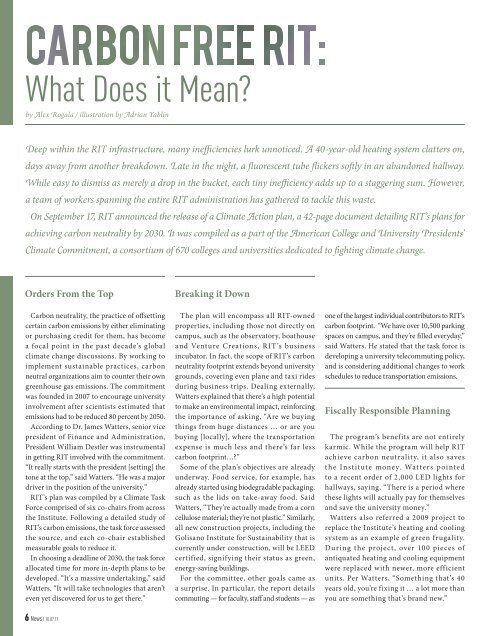Apologies - Reporter Magazine
Apologies - Reporter Magazine
Apologies - Reporter Magazine
You also want an ePaper? Increase the reach of your titles
YUMPU automatically turns print PDFs into web optimized ePapers that Google loves.
y Alex Rogala / illustration by Adrian Yablin<br />
Deep within the RIT infrastructure, many inefficiencies lurk unnoticed. A 40-year-old heating system clatters on,<br />
days away from another breakdown. Late in the night, a fluorescent tube flickers softly in an abandoned hallway.<br />
While easy to dismiss as merely a drop in the bucket, each tiny inefficiency adds up to a staggering sum. However,<br />
a team of workers spanning the entire RIT administration has gathered to tackle this waste.<br />
On September 17, RIT announced the release of a Climate Action plan, a 42-page document detailing RIT’s plans for<br />
achieving carbon neutrality by 2030. It was compiled as a part of the American College and University Presidents’<br />
Climate Commitment, a consortium of 670 colleges and universities dedicated to fighting climate change.<br />
Orders From the Top Breaking it Down<br />
Carbon neutrality, the practice of offsetting<br />
certain carbon emissions by either eliminating<br />
or purchasing credit for them, has become<br />
a focal point in the past decade’s global<br />
climate change discussions. By working to<br />
implement sustainable practices, carbon<br />
neutral organizations aim to counter their own<br />
greenhouse gas emissions. The commitment<br />
was founded in 2007 to encourage university<br />
involvement after scientists estimated that<br />
emissions had to be reduced 80 percent by 2050.<br />
According to Dr. James Watters, senior vice<br />
president of Finance and Administration,<br />
President William Destler was instrumental<br />
in getting RIT involved with the commitment.<br />
“It really starts with the president [setting] the<br />
tone at the top,” said Watters. “He was a major<br />
driver in the position of the university.”<br />
RIT’s plan was compiled by a Climate Task<br />
Force comprised of six co-chairs from across<br />
the Institute. Following a detailed study of<br />
RIT’s carbon emissions, the task force assessed<br />
the source, and each co-chair established<br />
measurable goals to reduce it.<br />
In choosing a deadline of 2030, the task force<br />
allocated time for more in-depth plans to be<br />
developed. “It’s a massive undertaking,” said<br />
Watters. “It will take technologies that aren’t<br />
even yet discovered for us to get there.”<br />
The plan will encompass all RIT-owned<br />
properties, including those not directly on<br />
campus, such as the observatory, boathouse<br />
and Venture Creations, RIT’s business<br />
incubator. In fact, the scope of RIT’s carbon<br />
neutrality footprint extends beyond university<br />
grounds, covering even plane and taxi rides<br />
during business trips. Dealing externally,<br />
Watters explained that there’s a high potential<br />
to make an environmental impact, reinforcing<br />
the importance of asking, “Are we buying<br />
things from huge distances … or are you<br />
buying [locally], where the transportation<br />
expense is much less and there’s far less<br />
carbon footprint…?”<br />
Some of the plan’s objectives are already<br />
underway. Food service, for example, has<br />
already started using biodegradable packaging,<br />
such as the lids on take-away food. Said<br />
Watters, “They’re actually made from a corn<br />
cellulose material; they’re not plastic.” Similarly,<br />
all new construction projects, including the<br />
Golisano Institute for Sustainability that is<br />
currently under construction, will be LEED<br />
certified, signifying their status as green,<br />
energy-saving buildings.<br />
For the committee, other goals came as<br />
a surprise. In particular, the report details<br />
commuting — for faculty, staff and students — as<br />
one of the largest individual contributors to RIT’s<br />
carbon footprint. “We have over 10,500 parking<br />
spaces on campus, and they’re filled everyday,”<br />
said Watters. He stated that the task force is<br />
developing a university telecommuting policy,<br />
and is considering additional changes to work<br />
schedules to reduce transportation emissions.<br />
Fiscally Responsible Planning<br />
The program’s benefits are not entirely<br />
karmic. While the program will help RIT<br />
achieve carbon neutrality, it also saves<br />
t he Institute money. Watters pointed<br />
to a recent order of 2,000 LED lights for<br />
hallways, saying, “There is a period where<br />
these lights will actually pay for themselves<br />
and save the university money.”<br />
Watters also referred a 2009 project to<br />
replace the Institute’s heating and cooling<br />
system as an example of green frugality.<br />
During the project, over 100 pieces of<br />
antiquated heating and cooling equipment<br />
were replaced with newer, more efficient<br />
units. Per Watters, “Something that’s 40<br />
years old, you’re fixing it … a lot more than<br />
you are something that’s brand new.”<br />
Departmental Goals<br />
In the 42 pages of RIT’s Climate Task Force’s<br />
Climate Action Plan, co-chairs of six different<br />
departments developed specific plans to<br />
achieve carbon neutrality. The following is a<br />
brief except from each group’s goals.<br />
Going Forward<br />
While the initial plan dictates a clear path,<br />
there are more changes in the works. For<br />
certain objectives, the task force decided<br />
additional research was necessary. “There is<br />
a tremendous amount of work in there,” said<br />
Watters. “It will take time for the university<br />
community to simply digest all those changes.”<br />
Watters attributes some of this flexibility to<br />
constantly improving green technology. He<br />
specifically pointed to new windows being<br />
used in the Golisano Institute for Sustainability<br />
building. “There are going to be windows<br />
in that building that are seven times more<br />
environmentally friendly than the last building<br />
that we built,” he explains, “We didn’t have that<br />
technology the last time we built a building.”<br />
It’s likely that plans will change even more.<br />
Earlier this year, RIT appointed Enid Cardinal<br />
as the Institute’s new senior sustainability<br />
manager, and Watters expects she’ll make her<br />
own mark on the plan. Said Watters, “We’ve<br />
got the program up and running and we made<br />
some great strides, but now we have a person<br />
who will spend nothing but full time, 100<br />
percent on this plan.”<br />
Between 2013 and 2029, the task force will<br />
prepare 10 bi-annual follow-up reports, before<br />
releasing a final “Zero Emission Report” in 2030.<br />
While much of the work is still years away, the<br />
capacity for change starts now. “Every day the<br />
university is doing something to move itself<br />
closer to that carbon neutral commitment,”<br />
said Watters. Work has only just begun, but for<br />
the group, it’s a chance to reposition the entire<br />
university piece by piece.<br />
Food Service<br />
*Investigate the purchase of recyclable<br />
dishware, utensils and packaging.<br />
*Improve water usage by food service locations.<br />
*Work towards recycling cooking oil.<br />
*Develop a compost policy.<br />
6 News | 10.07.11 75<br />
Recycling<br />
*Work to recycle over 50 percent of campus waste.<br />
*Develop a campus-wide recycling contest.<br />
*Create a campus recycling bin map.<br />
Grounds<br />
*Replace gas powered equipment with lower<br />
emission alternatives.<br />
*Reduce use of nitrogen-based fertilizers.<br />
Adapted from RIT’s 2011 Climate Action Plan<br />
Facility Operations<br />
* Plan new construction and renovation<br />
projects to LEED standards.<br />
* Develop a replacement vehicle policy using<br />
green fuel vehicles.<br />
Transportation<br />
*Encourage the use of low-energy vehicles,<br />
such as hybrids.<br />
*Develop a bike infrastructure.<br />
*Develop cost-effective commuter options<br />
and bus route alternatives.<br />
*Develop incentives for shared rides.<br />
Purchasing<br />
*Develop sustainable purchasing policy.<br />
*Encourage swaps and resale of supplies.<br />
*Develop Energy Star compliant computer<br />
configurations.<br />
*Schedule routine electronic waste disposal.









